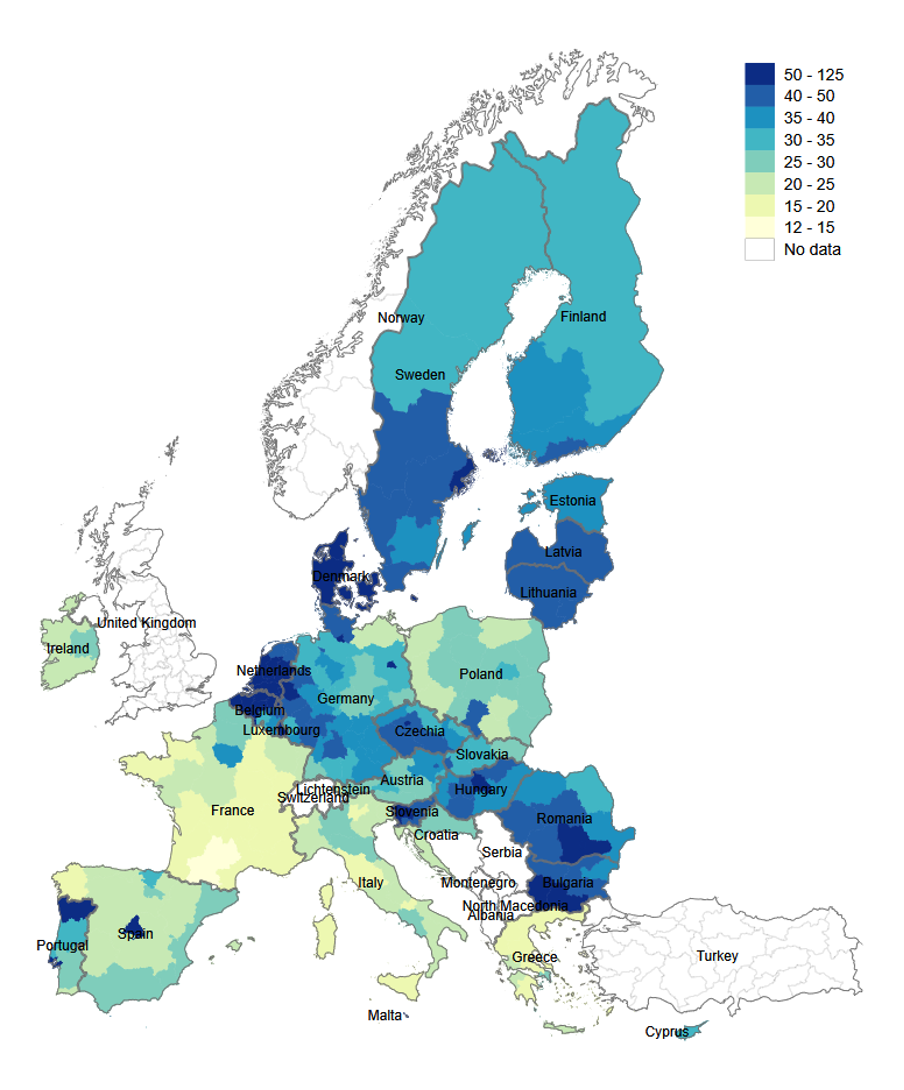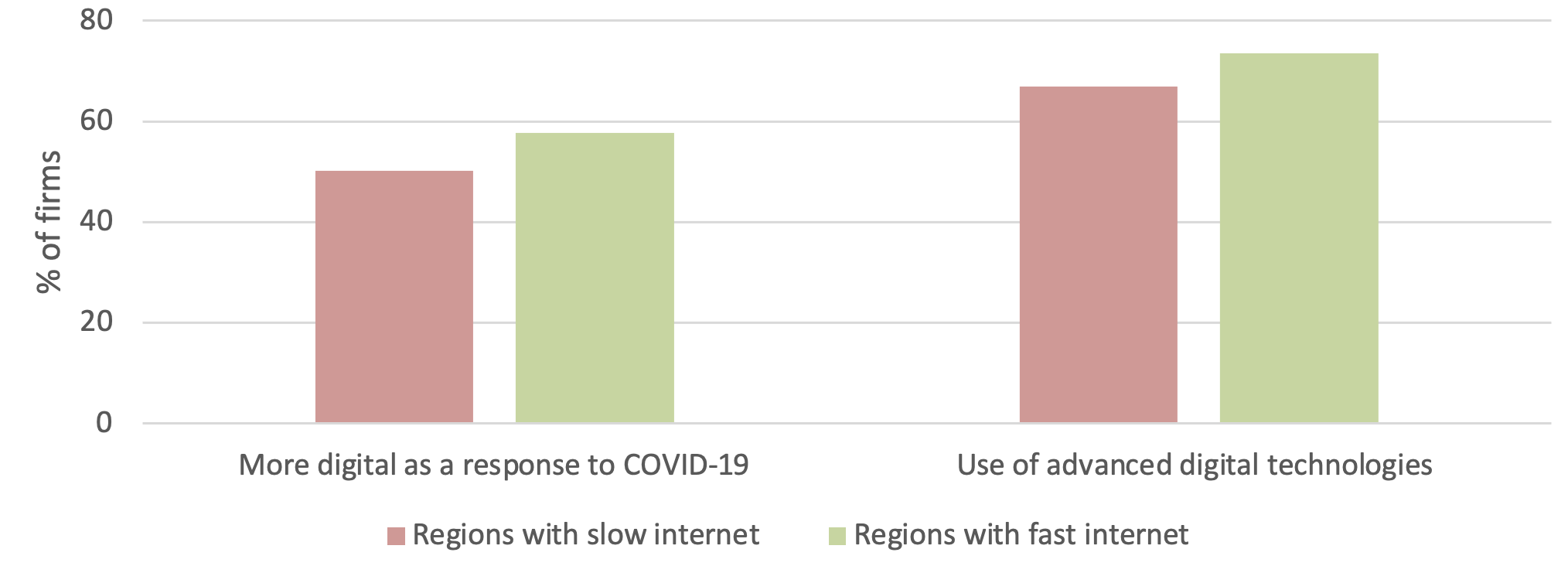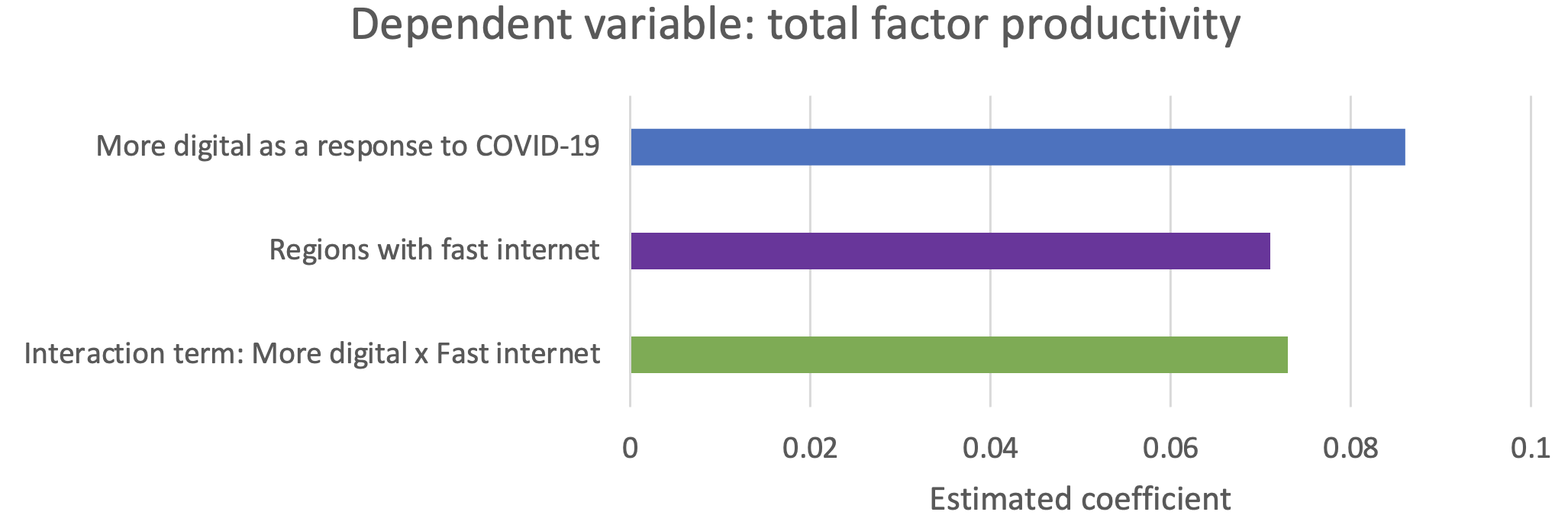Advanced digital technologies – such as 3D printing, advanced robotics, augmented reality, drones, online platforms, the internet of things, big data analytics, and artificial intelligence – are spreading rapidly in the US and the EU (Acemoglu et al. 2022, EIB, 2022, Fernandez-Macias et al. 2020). This has been encouraged by declining costs (Graetz and Michaels 2018, Brynjolfsson and McElheran 2016) and most recently accelerated by the COVID-19 pandemic.
The COVID crisis made digitalisation integral to firms’ survival. More than half of firms in the EU surveyed for the EIB Investment Survey (EIBIS), conducted from April to July 2022, said they responded to the pandemic by investing in digitalisation. Digital firms were better able to cope with the disruption unleashed by the pandemic, and they were less likely than non-digital firms to see sales decline significantly from 2020 onwards (EIB 2022). Digital firms are also more proactive in investing in climate change measures and adaptation and are better able to transform to address trade shocks and structural changes caused by the green transition (EIB 2023).
Despite rapid advancements of digital technology uptake among EU firms, the EU is at risk of being overtaken in technological innovation, in particular for advanced digital technologies. Among the leading companies in software and computer services, EU firms represent only 7% of R&D expenditure, compared with 71% for the US and 15% for China (Figure 1). Similarly, the EU accounts for 12% of R&D expenditure among leading companies producing technology hardware and electronic equipment, compared with 40% for the US and 19% for China. This might have long term consequences for the competitiveness, resilience, and renewal of the EU economy.
Figure 1 Share of global business R&D expenditure in 2020
Source: Authors’ calculations based on the EU Industrial R&D Investment Scoreboard.
Note: Share of R&D expenditure by the top 2,500 R&D investors, by sector and country.
Technological innovation in upstream sectors is a driver of firms’ uptake of digital technologies
Operating in more innovative environments supports firms’ digitalisation efforts. Firms operating in highly digital innovative environments were more likely to invest in digitalisation as a response to COVID-19 (EIB 2023). Furthermore, innovation in digital technologies in an industrial sector tends to foster the adoption of digital technologies by European firms operating in that same sector (Figure 2). The digital patent intensity of a sector (i.e. the number of digital patents divided by all patents held in that sector) is strongly associated with digital adoption in that sector – including after controlling for firm characteristics such as firm size, age, country, sector, and year. In other words, firms operating in sectors where digital innovation is particularly active are more likely to use digital technologies.
Figure 2 Digital innovation intensity and digital adoption
Source: Authors’ calculations based on EIBIS for digital adoption and the JRC-OECD COR&DIP database v.3 for digital innovation.
Note: Digital innovation is measured with the share of digital patents in a sector (the number of digital patents divided by all patents held in that sector).
The diffusion of digital innovation is also likely to be driven by the activities of the sectors that firms trade with. The internet and digital technologies have improved trade-related information flows and reduced communication costs. They have made it easier for firms to find foreign buyers or to integrate foreign customers and suppliers into their production processes, enhancing participation in global value chains and reaping the benefits of economics of scales (Abel-Koch 2013, WTO 2019). Trade in digital services from the EU has also rapidly been growing over time in the past decade.
To take a more macroeconomic perspective, we rely on input-output tables. These depict inter-industry relationships within an economy, showing how the output from one industrial sector may become an input to another industrial sector. They illustrate how dependent each sector is on every other sector, both as a purchaser of outputs from other sectors (upstream sectors that are sources of inputs) and as a supplier of inputs (downstream sectors, to which intermediate inputs are sold). The purchasers of outputs and the suppliers of inputs can also operate within the same sector. We find that digital innovation in upstream sectors is strongly associated with digital adoption.
Firms started to leverage on the positive effects of digitalisation. We show that firms that adopt digital technologies tend to be more productive, grow faster (in terms of employment), are more likely to invest in employee training and use strategic monitoring systems (with key performance indicators) for their operations (Table 1).
Table 1 Digital adoption and firm performance
Source: EIBIS (2019, 2020, 2021).
Note: Labour productivity in natural logarithm; positive employment growth, investment in employee training and the use of management practice (formal strategic business monitoring system with key performance indicators) are binary variables. The OLS regressions control for firm size, age, year, country and sector (27 EU countries and 12 sectors). Robust standard errors in parentheses. *** p<0.01, ** p<0.05, * p<0.1.
Digital infrastructure and firms’ digital adoption
Digital infrastructure played a critical role during the COVID-19 crisis. Fourteen percent of EU firms surveyed in the latest EIBIS consider access to digital infrastructure to be a major obstacle to investment. A key consideration is internet access and speed. Using Ookla data on internet speeds, Figure 3 shows that significant differences exist in the quality of digital infrastructure between EU regions and countries.
Figure 3 Internet speed estimates at NUTS2 level in the EU in 2019
Source: Authors’ calculations based on Ookla. https://github.com/teamookla/ookla-open-data
Note: The figure shows data from 2019Q1 and is based on more than 11 million internet speed tests during this period. Internet speed is proxied by the measure of average latency when internet speed tests are performed using the website Speedtest.net. Latency is the time it takes for data to be transferred between its original source and its destination, measured in microseconds. The measure is transformed as the inverse of latency (one over latency) to show a positive increase when internet speed is higher. The original data is provided at the level of mercator tiles (approximately 610.8 meters by 610.8 meters at the equator), which is aggregated to NUTS2 level averages, using the number of tests as weights.
In EIB (2023), we show that regions with faster internet speed (where internet speed is above the median speed across NUTS regions) tend to have a higher share of digital firms (Figure 4). In terms of business dynamics, this illustrates the concentration of digital firms in regions with better digital infrastructure.
Figure 4 Regional internet speed and digital adoption
Source: Authors’ calculations based on EIBIS and Ookla.
We also find that the returns from digitalisation are higher for firms located in regions with better infrastructure and faster internet speed. Better digital infrastructure has provided additional productivity gains for firms that invested in becoming more digital as a response to COVID-19.
In regression analysis, the effect can be seen as the positive interaction between investment in digitalisation and fast internet (Figure 5). This highlights how critical digital infrastructure was in supporting firms’ rapid digital transformation during the pandemic. More generally, it also illustrates how complementary public and private digital investments can improve firm performance and economic resilience.
Figure 5 Digital adoption, digital infrastructure, and firm productivity
Source: Authors’ calculations based on EIBIS and Ookla.
Note: The OLS regression controls for firm size, firm age, country and sector (three group of EU countries and four macroeconomic sectors). Region with slow internet: NUTS2 region with average latency higher than the median latency across all regions (based on Ookla data). The estimated coefficients are statistically significant at 1% significance level.
Policy conclusions
Digitalisation can be a driver of firm resilience and is critical to adapting quickly to changing environments. The external environment in which firms operate contributes significantly to their digitalisation efforts. Digital infrastructure and technological innovation can limit or enhance digital adoption. The analysis presented in this column shows how firms’ operating environment can enable digitalisation and maximise returns from digitalisation investments.
Successfully managing the digital transition and taking advantage of its long-term benefits goes beyond technology. The digital transformation is a societal change. Striking the right technological balance is a complex process for the EU. It is caught between global players that constitute the cutting edge of digital innovation, national preferences, and societal and regulatory patterns that set boundaries on the use of digital technologies.
To make the most of the digital transformation, the EU will need to position itself well in the global environment, creating better internal conditions for innovation in technologies that are crucial to European interests and taking full advantage of the benefits of digitalisation, while staying within the boundaries of the European economic model.
References
Abel-Koch, J (2013), “Who Uses Intermediaries in International Trade? Evidence from Firm-level Survey Data,” The World Economy 36(8): 1041-1064.
Acemoglu, D, G Anderson, D Beede, C Buffington, E Childress, E Dinlersoz, L Foster, N Goldschlag, J Haltiwanger, Z Kroff, P Restrepo and N Zolas (2022), “Automation and the Workforce: A Firm-level View from the 2019 Annual Business Survey,” NBER Working Paper 14741.
Brynjolfsson, E and K McElheran (2016), “The Rapid Adoption of Data-driven Decision-making,” American Economic Review 106(5): 133-39.
EIB – European Investment Bank (2022), Digitalisation in Europe 2021-2022 Evidence from the EIB Investment Survey.
EIB (2023), Investment Report 2022/2023: Resilience and Renewal in Europe.
European Commission (2022), Science, Research and Innovation Performance of the EU 2022: Building a Sustainable Future in Uncertain Times, Publications Office of the European Union.
Fernandez-Macias, E, D Klenert. and J.-I. Antón (2022), “Don't Blame it on the Machines: Robots and Employment in Europe”, VoxEU.org, 24 February.
Graetz, G and G Michaels. (2018), “Robots at Work,” Review of Economics and Statistics, 100(5), 753-768 (see also the Vox column here).
WTO (2019), Global Value Chain Development Report 2019: Technological Innovation, Supply Chain Trade, and Workers in a Globalized World, World Trade Organization.












